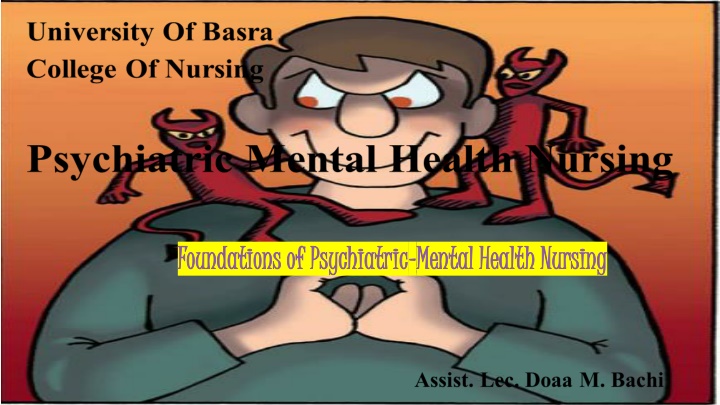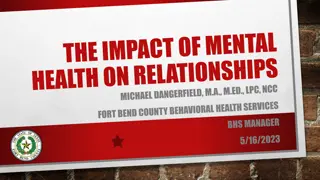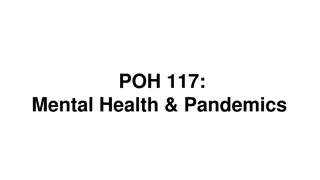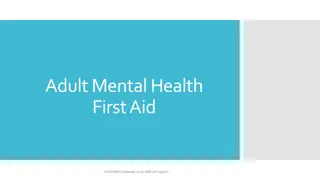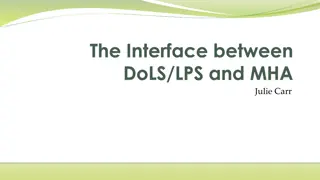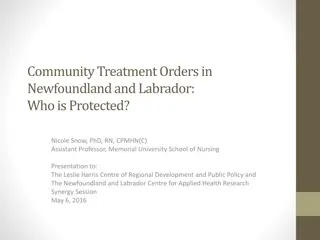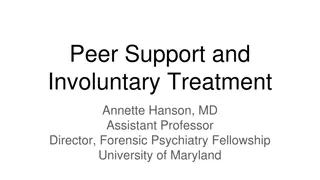Evolution of Mental Health Treatment Through History
Beliefs and attitudes towards mental health have evolved significantly over history. From ancient times where mental disorders were associated with divine or demonic origins to the period of Enlightenment and the creation of asylums for protection, the treatment of mental illness has transitioned through various phases. This journey reflects changing societal perceptions and approaches towards individuals with mental health issues.
Download Presentation

Please find below an Image/Link to download the presentation.
The content on the website is provided AS IS for your information and personal use only. It may not be sold, licensed, or shared on other websites without obtaining consent from the author.If you encounter any issues during the download, it is possible that the publisher has removed the file from their server.
You are allowed to download the files provided on this website for personal or commercial use, subject to the condition that they are used lawfully. All files are the property of their respective owners.
The content on the website is provided AS IS for your information and personal use only. It may not be sold, licensed, or shared on other websites without obtaining consent from the author.
E N D
Presentation Transcript
Foundations of Psychiatric Foundations of Psychiatric Mental Health Nursing Mental Health Nursing
History concepts History concepts I. I. Ancient Ancient Times Times People of ancient times believed that any sickness indicated displeasure of the gods and, in fact, was a punishment for sins and wrongdoing. Those with mental disorders were viewed as either divine or demonic, depending on their behavior. Individuals seen as divine were worshipped and adored; those seen as demonic were ostracized, punished, and sometimes burned at the stake.
Later, Aristotle (382322 BC) attempted to relate mental disorders to physical disorders and developed his theory that the amounts of blood, water, and yellow and black bile in the body controlled the emotions. These four substances, or humors, corresponded with happiness, calmness, anger, and sadness. Imbalances of the four humors were believed to cause mental disorders; therefore, treatment was aimed at restoring balance through bloodletting, starving, and purging. Such treatments persisted well into the 19th century.
In early Christian times (11000 AD), primitive beliefs and superstitions were strong. All diseases were again blamed on demons, and the mentally ill were viewed as possessed. Priests performed exorcisms to rid sufferers of evil spirits. When that failed, they used more severe and brutal measures, such as incarceration in dungeons, flogging, and starving. In England during the Renaissance (1300 1600), people with mental illness were distinguished from criminals. Those considered harmless were allowed to wander the countryside or live in rural communities, but the more dangerouslunatics were thrown in prison, chained, and starved.
In 1547, the Hospital of St. Mary of Bethlehem was officially declared a hospital for the insane, the first of its kind. By 1775, visitors at the institution were charged a fee for the privilege of viewing and ridiculing the inmates, who were seen as less than human animals. During this same period in the colonies (later the United States), the mentally ill were considered evil or possessed and were punished.
II. II. Period Institutions Period of of Enlightenment Institutions Enlightenment and and Creation Creation of of Mental Mental In the 1790s, a period of enlightenment concerning persons with mental illness began. Philippe Pinel in France and William Tuke in England formulated the concept of asylum as a safe refuge or haven offering protection at institutions where people had been whipped, beaten, and starved because they were mentally ill.
III. III. Sigmund Sigmund Freud Freud and and Treatment Treatment of of Mental Mental Disorders Disorders The period of scientific study and treatment of mental disorders began with Sigmund Freud (1856 1939) and others, such as Emil Kraepelin (1856 1926) and Eugen Bleuler (1857 1939). With these men, the study of psychiatry and the diagnosis and treatment of mental illness started in earnest. Freud challenged society to view human beings objectively. He studied the mind, its disorders, and their treatment as no one had done before.. Kraepelin began classifying mental disorders according to their symptoms, and Bleuler coined the term schizophrenia.
IV. IV. Development Development of of Psychopharmacology Psychopharmacology A great leap in the treatment of mental illness began in about 1950 with the development of psychotropic drugs, or drugs used to treat mental illness.
V. V. Move Move toward toward Community Community Mental Mental Health Health The movement toward treating those with mental illness in less restrictive environments gained momentum in 1963 with the enactment of the Community Mental Health Centers Construction Act. Deinstitutionalization, a deliberate shift from institutional care in state hospitals to community facilities, began. Community mental health centers served smaller geographic catchment, or service, areas that provided less restrictive treatment located closer to individuals homes, families, and friends. These centers provided emergency care, inpatient care, outpatient services, partial hospitalization, screening services, and education.
MENTAL ILLNESS IN THE 21ST CENTURY MENTAL ILLNESS IN THE 21ST CENTURY Some believe that deinstitutionalization has had negative as well as positive effects. Although deinstitutionalization reduced the number of public hospital beds by 80%, the number of admissions to those beds correspondingly increased by 90%. Such findings have led to the term revolving door effect. Although people with severe and persistent mental illness have shorter hospital stays, they are admitted to hospitals more frequently. The continuous flow of clients being admitted and discharged quickly overwhelms general hospital psychiatric units. The practice of boarding leads to frustration of health care personnel, dissatisfaction with care for clients and their families, and some believe an increase in suicide.
Concept of Mental Health and Mental Illness Concept of Mental Health and Mental Illness Psychiatry: is the branch of medicine which deals with the diagnosis, treatment and prevention of mental illness. Psychiatric nursing: is a branch of nursing concerned with the promotion of mental health, prevention of mental disorder and provide nursing care for patient who is suffer from mental disorder. Mental health and mental illness are difficult to define and are influenced by one s culture and society. The World Health Organization defines health as a state of complete physical, mental, and social wellness, not merely the absence of disease or infirmity.
MENTALHEALTH Mental Health a state of emotional, psychological, and social wellness evidenced by satisfying interpersonal relationships, effective behavior and coping, positive self-concept, and emotional stability. Characteristics Characteristics of of Mental Mental Health Health A positive attitude toward self 1. Growth, development, and the ability to achieve self-actualization 2. Integration 3. Autonomy and independence. 4. Perception of reality 5. Environmental mastery. 6.
Factors that Influencing Mental Health Factors that Influencing Mental Health Individual Factors (biologic makeup, I. autonomy and independence, self-esteem, capacity for growth, vitality, ability to find meaning in life, resilience or hardiness, sense of belonging, reality orientation, and coping or stress management abilities).
Interpersonal Factors, including (effective communication, II. helping others, intimacy, and maintaining a balance of separateness and connectedness). III. Social/Cultural Factors, including (sense of community, access to resources, intolerance of violence, support of diversity among people, mastery of the environment, and a positive yet realistic view of the world).
MENTALILLNESS is an illness or syndrome that affect mood, behavior, and thinking, such as depression, schizophrenia, anxiety disorders, and addictive disorders. Mental disorders often cause significant distress or impaired functioning or both. dissatisfaction with self, relationships, and ineffective coping Individuals experience
Characteristics of Mental Characteristics of Mental illness illness 1. Inability to cope 2. Inability to establish a meaningful relationship. 3. Displays poor judgment. 4. Exhibits dependency needs. 5. Inability to perceive reality. 6. Avoid problems.
Factors Contributing to Mental Illness Factors Contributing to Mental Illness 1. Individual Factors include (biologic makeup, intolerable or unrealistic worries or fears, inability to distinguish reality from fantasy, intolerance of life s uncertainties, a sense of disharmony in life, and a loss of meaning in one s life). 2. Interpersonal Factors include excessive dependency on or withdrawal from relationships, no sense of belonging, inadequate social support, and loss of emotional control). (ineffective communication,
3. Social/Cultural Factors include (lack of resources, violence, homelessness, poverty, an unwarranted negative view of the world, and discrimination such as stigma, racism, classism, ageism, and sexism. It is important to note that some of these social/cultural factors can result in isolation, feelings of alienation, and maladaptive, violent, or criminal behavior).
Diagnostic And Statistical Manual Of Mental Disorders The Diagnostic and Statistical Manual of Mental Disorders, fifth edition (DSM-5), is a taxonomy published by the American Psychiatric Association and revised as needed. The current edition made some major revisions and was released in 2013. The DSM-5 has three purposes: 1. To provide a standardized nomenclature and language for all mental health professionals 2. To present defining characteristics or symptoms that differentiate specific diagnoses 3. To assist in identifying the underlying causes of disorders
The classification system allows the practitioner to identify all the factors hat relate to a person s condition: I. All major psychiatric disorders such as depression, schizophrenia, anxiety, and substance-related disorders II. Medical conditions that are potentially relevant to understanding or managing the person s mental disorder as well as medical conditions that might contribute to understanding the person III. Psychosocial and environmental problems that may affect the diagnosis, treatment, and prognosis of mental disorders. Included are problems with the primary support group, the social environment, education, occupation, housing, economics, access to health care, and the legal system.
